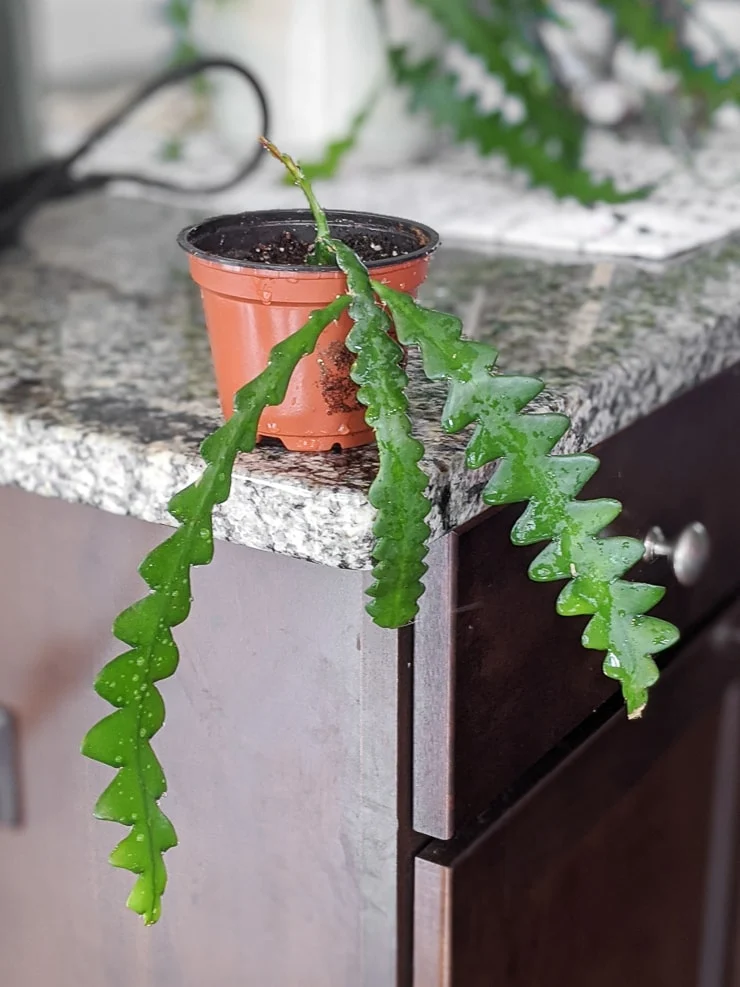How to help the ric rac cactus thrive!
I ordered my first ric rac cactus online many years ago—it’s such a cool-looking plant and was on my wish list for a while. You might hear it called a ton of different names: the fishbone cactus, the zig-zag cactus, or even an orchid cactus.
It’s a tropical cactus from Mexico and actually doesn’t have leaves—everything you see on the plant is a stem. Just a bunch of really cool stems. I have a YouTube care video about this one that you can watch as well.

Care overview
- Bright indirect light; acclimate slowly to prevent scorching if moved outdoors.
- Allow the top several inches of soil to dry before thoroughly soaking the plant again.
- Wrinkling stems indicate thirst; yellowing and consistently wet soil can lead to root rot.
- Use a well-draining soil mix.
- Fine in typical household temperatures and humidity levels.
- Fast growers that prefer to be root-bound; repot every 1-2 years.
- Non-toxic to pets and children.

Light
Bright, indirect light is best. Despite having “cactus” in its name, the ric rac cactus does not like full sun. As a tropical cactus, it is grows in evergreen forests and lowland rainforests. Therefore, much of the direct light is blocked by a dense canopy of tree foliage.
Too much direct light can scorch your plant. I have mine in a window that gets bright midday, afternoon, and early evening sun. If you choose to move your plant outdoors during the warmer months, it does best in shaded areas just out of direct sun. Acclimate it slowly to even dappled direct light.
I have seen firsthand what happens when you don’t adapt your plant slowly. When we moved to our new house, I didn’t have space for all of my plants. So I put my ric rac cactus outside behind a bush that I thought would shade it enough. But what happened? It burned to hell and back. I was so angry at myself! Avoid that happening to you.
If new growth on your ric rac cactus is long and skinny with less-defined “teeth,” it is likely due to a lack of light. The plant is probably reaching for the light, causing the stretching. Give the plant more light and see what the new growth does. It’s perfectly fine to prune off leggy growth. This could help the plant branch a bit and give it a fuller look, too.

Water
Although ric rac cactuses can go prolonged periods of time without water, they will produce healthier new growth if you water them slightly more than you would your average cactus. When you water this plant, you want to thoroughly soak it. Remember, its natural habitat is the rainforest.
Water when the top few inches of soil dry out. Be careful to avoid overwatering, which can lead to root rot. For my growing conditions, this generally means that I water my ric rac plants every week in the spring and summer and every 10-14 days in the late fall and winter.
If the stems on your ric rac cactus are wrinkly, it’s likely thirsty. Its fleshy stems do a good job of helping it through periods of drought, but don’t push it! Don’t let the soil dry out completely before watering the plant again—this plant doesn’t store water like a traditional cactus does.
If you notice that the stems are wrinkly and yellowing and the soil has been consistently wet, this can be a sign of overwatering and root rot. But, I’d say wrinkling is way more common in underwatered plants.

Soil
One way to help you avoid overwatering your ric rac cactus is to choose the right soil. For my plant, I made a standard cactus/succulent soil mix and added some coco coir in. I always keep a brick of coco coir and a bag of perlite on hand to amend soil for different plants.
A well-draining soil is essential because it helps the excess water flow away from your plant’s root ball and out of the pot’s drainage holes. It also helps with lightweight soil retention. If your soil is too dense and heavy, it can choke the plant’s roots.
Temperature & humidity
The ric rac plant tolerates all normal household temperatures just fine. If you want to grow your ric rac cactus outdoors, you must live somewhere where it stays above roughly 50 degrees Fahrenheit year round. This plant will not tolerate cold temps, and it will die in freezing climates.
Since it comes from the rainforest, this tropical cactus enjoys higher levels of humidity. However, it is resilient and does fine in normal household humidity levels, too. I do not have a humidifier with my plant, and it has grown like crazy over the years.

Growth & repotting
They are quite prolific growers in ideal care conditions. The stems grow up to about a foot long, spilling over the edges of containers. They can also branch out when pruned. As your plant ages, don’t be alarmed if some of the older stems develop a woody or cork-like brown base to them. This is a normal sign of the plant maturing.
It also doesn’t mind being a bit rootbound, and it grows best when it’s snug in its pot. I would recommend repotting every 1-2 years depending on the growth rate. Check the drainage holes for signs of the roots popping out and looking for more room before sizing your pot up.
When you do repot, choose a pot only about an inch or two larger. And refresh the plant with fresh soil. I have had one of my ric rac plants for over 5 years and have repotted it only once despite it nearly tripling in size.
Flowering
Both types of ric rac or fishbone cactus bloom—and only at night. Epiphyllum/disocactus anguliger generally produces white flowers in the fall, while selenicereus anthonyanus produces pink flowers in the spring and summer. My ric rac has bloomed gorgeous white flowers many times (see photo below).
You can encourage flowering by letting your plant mature and keeping it in optimal care conditions. I know, I know. That’s not a shortcut! But sometimes there aren’t shortcuts with plants. My queen of the night didn’t bloom for years, and now it blooms nonstop all year long.
A diluted liquid fertilizer for cactuses or orchids can help keep this plant healthy, but it should be used sparingly. Feed the plant in the spring. Don’t over-fertilize. Ric rac cactuses also have the best chance of flowering when they are a bit rootbound.

Propagation
Propagating a ric rac cactus is very similar to propagating other succulent stems and leaves. You can propagate this plant using cuttings in directly in soil. While you can propagate in water, the the soil propagation is usually so successful that I skip water.
Here are the steps:
- Cut a piece of a stem off. Make sure it’s a few inches long.
- Let the cut end of the cutting dry out for a day or two and harden over. This is critical because, if you don’t, the cutting will be more susceptible to rot.
- Plant in a well-draining soil or succulent soil.
- Water every week or so when the soil dries out; give bright indirect light.
- The cutting will develop roots and become a new plant.
If your plant is mature enough with multiple growth points, you can also divide a plant. To do so, simply take it out of the pot and gently remove the soil around the root ball. Once you find a spot you can break off, do so gently, making sure to take some of the root system with you.
Then pot the plant up separately with fresh soil. Since they already have roots, you don’t need to keep things that moist. This is exactly the process I took separating a baby from my mom’s ric rac cactus below!

Toxicity & pests
I outlined this plant as one of my favorite plants that are non-toxic to cats, dogs, and kids. So it’s safe to have them around. But remember that these are not meant for consumption, so it’s best to keep them away from curious chompers.
They are also not particularly vulnerable to pests, but keep an eye out for signs of scale, which leaves a tell-tale sticky orangish residue. If you notice an infestation while wiping down your plant’s leaves, isolate the plant immediately and treat it using an insecticide designed for houseplants and the pest you’re treating.
Selenicereus vs. epiphyllum
Scientifically, “ric rac” or “zig zag” cactus could actually be one of two very similar plants: selenicereus anthonyanus (older version classification: cryptocereus anthonyanus) or epiphyllum anguliger or disocactus anguliger.
A note on that last one—the plant was reclassified from epiphyllum to disocactus a few years ago due to recent molecular research. But I haven’t really seen that name used widely at all, so I’m including the epiphyllum classification here.
Selenicereus anthonyanus and epiphyllum/disocactus anguliger truly do look remarkably similar. But there are some differences when you look at them side by side. Look at the two photos below. The first is my epiphyllum/disocactus anguliger; the second is my mom’s selenicereus anthonyanus.
You can see that the stem “teeth” on my plant (green pot) are slightly more rounded than the teeth on my mom’s plant (white and gray pot). My mom’s plant also slightly deeper “teeth.”
Flowering help to confirm a plant’s true identity, too. The selenicereus anthonyanus type of ric rac produces pink flowers, while the epiphyllum/disocactus anguliger produces white flowers. My plant has bloomed, so I am certain it is an epiphyllum/disocactus anguliger.
All of that said, whichever plant you have—you can safely call it a ric rac, zig zag, or fishbone cactus and follow the care tips in this guide. They work for both plants 🙂


In conclusion…
Remember, the key to a thriving ric rac is in mimicking its natural habitat—bright, indirect light, well-draining soil, and the right balance of humidity and watering. You’ll be glad you added this gorgeous plant to your collection. Happy planting!

Pin my tips!


Brittany is a seasoned DIY home and garden expert, running a creative brand since 2014 that inspires others with approachable plant care guides, woodworking tutorials, and decor projects. She is a certified project manager and has completed extensive coursework in the art and science of growing your own plants. Her work has been recognized by major publications, and she routinely collaborates with fellow DIY industry leaders—but her favorite thing to do is inspire you! Learn more about her here.

Thank you for the info. I currently have 2 Ric Racs and I just lost one. I had ordered another through ETSY some time ago and it was supposed to be delivered between today and the 29th. No reasoning but today I received a eaiul stating the order was cancelled and supposedly issued a refund. I would like to purchase another and would love a referral as to where. Where I will get my plant. Thankyou for a reply.
Hi Mary Ann! It really depends on where you live. I would try Etsy again if you don’t have anything locally, but this time of year, it’s possible the shop cancelled due to conditions being too cold for the plant to survive shipping (even with a heat pack). I’d call any local nurseries you have nearby to see if they have any in stock. I also see them at places like Home Depot and Lowe’s sometimes.
That is a beautiful plant! I WANT ONE!!!
Play your cards right and you might get one for your birthday next year!